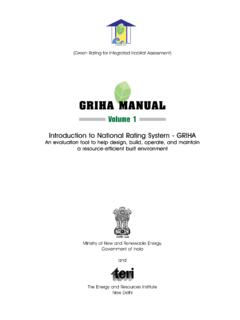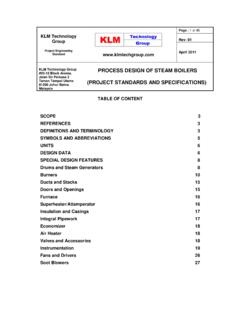Transcription of Energy Conservation Building Directives - Griha India
1 Energy Conservation Building Directive 2018(based on ECBC 2017)2 About this presentationEnergy Conservation Building Code one of the most effective tools to curb future Energy demand growth, deliver significant cost Energy savings to Building owners and users, while improving comfort and air quality;While effective development, implementation and enforcement of ECBC require coordinated efforts of multiples stakeholders at different levels, enforcement and implementation of ECBC lies with the state and local governments;The purpose of this presentation is to provide Urban Local Bodies (ULBs), as well as State Urban Development Departments (or State Designated Agencies) with key aspects of the ECBC and to help in adoption of ECBC.
2 This presentation is prepared by the Pacific Northwest National Laboratory in partnership with the Alliance for an Energy Efficient Outline3 IntroductionAbout ECBCRole of State and Local GovernmentsCase StudiesConclusions4 IntroductionAbout ECBCRole of State and Local GovernmentsCase StudiesConclusionsBreakdown of Electricity Consumption in India (2015 -2016)Source: CEA,2017 INTRODUCTION5 Building sector accounts for 33% of total electricity consumption in IndiaCommercial Building accounts for 9% of total electricity consumption in IndiaIndustry42%Agriculture17%Building33 %Other8%BuildingCommercial9%Domestic24%R est67%Breakdown of Electricity Consumption in Commercial BuildingsSource: BEE, 2017 INTRODUCTIONL ighting59%Air Conditioning31%Other10%6 Lighting and air conditioning are the largest Energy users in commercial buildingsCommercial Buildings Growth ForecastCurrently ~ 1,396million m2In 20years ~ 2,211million m2(estimated)*39%of Building stock in 2037is yet to be constructed* Source:AEEE, 2017aExisting, 61%To be build39%YEAR billion m2 Existing buildingsYEAR billion m2 INTRODUCTION7 Commercial Building Stock Growth Projections02004006008001000 HotelsHospitalsOffceBuildingsRetail SectorPlaces ofWorshipEducationalMillion m2 CurrentTo be builtINTRODUCTION* Source:AEEE, 2017a8 India will add more than 800,000 m2of commercial buildings in next 20 yearsSource.
3 CEA, 201716%16%12%11%-3%11%2%6%10%-5%0%5%10%1 5%20%010,00020,00030,00040,00050,00060,0 0070,00080,00090,000100,000% change over last yearGWhGWhGrowth in % over the previous yearGrowth of Electricity Consumption in Commercial Building Sector in IndiaElectricity consumption from commercial buildings grows at an annual rate of 9-10% on averageINTRODUCTION9 Dense compact settlementSun controlled by orientationStone texture on wall surfaces decreases effect of solar radiationHeavy thermal mass increases time lagCourtyards provide shade and ventilationEvaporative coolingLow window wall ratioZali as a shading devicePotted roof insulationSource: from Traditional BuildingsINTRODUCTION10 Energy Efficient BuildingsINTRODUCTION11 INTRODUCTIONB uilding design for Energy Efficiency: Importance of codes for new buildingsSource: BEEP, 20171213 IntroductionAbout ECBCRole of State and Local GovernmentsCase StudiesConclusionsECBC 2007 ECBC 2017 Energy Conservation Building Code, IndiaENERGY Conservation ACT 2001 Energy Conservation Act 2001 provides legal framework and institutional set-up for Energy efficiency policy, including Energy Conservation Building Code14 ABOUT ECBC 2017 Applies to new commercial buildings with a connected load of 100 kW & more or contract demand of 120 kVA or more.
4 Introducespassive design features such as daylight requirements and shading provisions;Introduces provisions of installing Renewable Energy Systems;Sets minimum Energy efficiency standards for design and construction;Encourages Energy efficient design or retrofit of buildings;Pathway toward Near Zero Energy BuildingsKey features15 ABOUT ECBC 201721%22%22%20%25%0%5%10%15%20%25%30%05 0100150200250 ColdCompositeHot DryModerateWarm HumidEnergy Savings, % Energy consumption, kWh/m2* BuildingECBCS avingsECBC-compliant buildings deliver 20-25% of Energy savings in different climates, when compared with typical buildingsSource: BEE, 201716 ABOUT ECBC 2017 Key featuresSavings compared with typical Building with the same area ECBC 2017 sets three Tiers of Building Energy Performance:ECBC(requires 25% less Energy than typical Building );ECBC+(requires 35% less Energy than typical Building );SuperECBC(requires 50% less Energy than typical Building ).
5 Source: AEEE, 20171725%35%50%Typical BuildingECBC CompliantECBC+SuperECBCABOUT ECBC 2017 ECBC 2017 Energy Savingsfor ProjectLegal RequirementsLong-Term BenefitsWhy ComplySource: AEEE, 201718 ABOUT ECBC 2017 Potential National Impact of ECBC 2017 Implementation50% Energy SAVINGS BY 203015 GWPEAK DEMAND REDUCTION250 Mt CO2eGHG ABATEMENTS ource: Government of India , 201719 INR 35000 CroreMONETARY SAVINGSABOUT ECBC 201720 Economic characteristics. Payback periodSource: USAID, 2017 Economic performance of ECBC 2017-compliant Building varies depending on type of Building , operational pattern of office Building (daytime use or 24h), location (climate zone)ABOUT ECBC star hotelShopping mallHospitalMedium Office, 8hrStar hotelPayback, years (composite climate)21 Source: USAID, 2017 Economic performance of ECBC 2017-compliant Building varies depending on type of Building , operational pattern of office Building (daytime use or 24h), location (climate zone)Economic characteristics.
6 Internal Rate of ReturnABOUT ECBC 2017 Note: IRR Internal Rate of Return16%13%12%12%9%0%2%4%6%8%10%12%14%1 6%18%No star hotelShopping mallHospitalMedium Office, 8hrStar hotelIRR, % (composite climate) Number and geographic distribution of climate zones remained the same as in ECBC 2007 ECBC 2017 provides climate zone data for major Indian citiesIndian Climate Zones22 ABOUT ECBC 2017 BuildingSystemsComplianceOptions EnergyCodeComplianceoBuilding EnvelopeoMechanical systems and equipment, including HVAC and water heatingoLightingoElectrical power, motors, and renewable energyMandatory Requirements Prescriptive method Building trade-off method Whole- Building performance methodCompliance Options23 ABOUT ECBC 2017 Component-based (prescriptive).
7 Requires little Energy expertise,provides minimum performance requirements,no flexibility;System-based (trade-off ): allows some flexibility through the balance of some high-efficiency components with other lower efficiency components;Whole Building design analysis (performance): allows flexibility in meeting or exceeding Energy efficiency requirements (as compared to a baseline Building )ApproachesMandatory Provisions for ECBCF lexibilityExpert KnowledgeUse of Energy Simulation1. PrescriptiveRequiredLowLowNo2. Trade-offRequiredMediumMediumNo3. Performance-basedRequiredHighHighYes24 ABOUT ECBC 2017 Compliance OptionsECBC 2007 Building envelope; HVAC; Lighting; Power; Water heating; 2017 Building envelope; Mechanical systems, including HVAC, water heating; Lighting; Electric power and renewable 2017 Plug loads; Equipment that uses Energy for manufacturing processes; Parts of the Building that use Energy for manufacturing components covered by ECBCC omponents not covered by ECBCA pplicable Building SystemsNotes:HVAC -Heating Ventilation and Air Conditioning25 ABOUT ECBC 2017 Building Envelope;Mechanical systems;HVAC;Water heating;Lighting;Electric power;Renewable Heating, Ventilation and Air- conditioning ;SHGC Solar Heat Gain Coefficient.
8 VLT Visible Light Transmittance 26 ABOUT ECBC 2017 Applicable Building SystemsHospitalityNo-star Hotels ResortStar HotelHealth CareHospitalsOut-patient HealthcareAssemblyTheatreTransport Service FacilitiesMultiplexBusinessSmall Offices (<10,000 m2)Medium Offices (10,000-30,000 m2)Large Office (>30,000 m2)EducationSchoolsCollegesUniversitiesT raining InstitutionsShopping FacilitiesShopping MallsStand-alone RetailsOpen Gallery MallsSuper MarketsECBC Building classifications 27 ABOUT ECBC 2017 Compliance requirements Building should comply with provisions of ECBC 2017:New commercial buildings with load demand > 100 kW or 120 kVA;Additions to existing commercial buildingsif connected load demand of Building with additions > 100 kW or 120 kVA;Alterations to existing commercial buildingsif altered part of Building or systems > 100 kW or 120 kVA of load demand28 ABOUT ECBC 2017 Building EnvelopeIn a composite climate, U-value of W/m2-K for walls yields 17% Internal Rate of Return and provides simple payback period of 5 years;Adequate daylighting can result in 20-30% of Energy savings; The impact of roof insulation 50% higher in buildings operating 24 hours, compared to 8 hours ECBC 2017 Source: USAID, 2017 Credit: PNNL, 201429 The better the insulation of the wall, the higher the Energy savings.
9 ECBC 2017 prescribes minimum requirements for opaque components (wall and roof), fenestration systems (window, skylight), shading, and day lightingECBC 2017 sets minimum requirements for light power density (LPD) of buildings and lighting control systems;Maximum LPD defined as per application area as W/m2;Occupancy sensor to automatically switch on/off the lights in buildings >20,000 m2after 15 minutes of inactivity;90% of interior lighting of buildings with area >300 m2should have automatic control systemsLighting. ECBC requirementsCredit: PNNLL ighting is largest electricity consuming end-user within a Building in Lighting Power DensityABOUT ECBC 201731 Lighting. Savings161413131111141210111010111089887 65655024681012141618 Retail/MallReligionbuildingHospitalsUniv ersity andSchoolsOfficeHotelLighting Power Density (W/m2)ECBC 2007 ECBC 2017 ECBC+SuperECBCThe lower the LPD value, the higher will be savings;Compared to ECBC 2007 minimum requirements, on average ECBC 2017 will deliver following savings in lighting (savings can be higher for typical buildings):ECBC 2017 ECBC +Super ECBC15%32%56%ABOUT ECBC 2017 Space ConditioningECBC encourage optimal size/capacity of HVAC systems, which helps decrease Energy costs;Equipment should meet minimum efficiency standards in terms of coefficient of performance (COP) for all tiers of compliance;Time clock provisions.
10 Controls for cooling towers, condenser fans, chilled water pumps;Use of economizer;Insulation requirements for the pipes and ductsCredit: Trane, PNNL32 ABOUT ECBC 2017 Comfort SystemsNatural ventilation should comply with guidelines of the National Building Code (NBC) and have at least 3-star rated ceiling fans;Mechanical ventilation systems should ensure air change rate in accordance with NBC and should have CO sensors for car park space > 600 m2;Buildings with area >50 m2, with occupant density >40 people per 100 m2should have demand control ventilationCredit: PNNL, DOE EERE33 ABOUT ECBC 2017 Educational and commercial buildings with area >20,000 m2and mechanical cooling and heating systems should have Building management systems and control systems including:Timeclock;Occupancy control;Fan controls;Temperature controls; Building Management Systems and ControlsCredit: PNNL, Ingersoll






